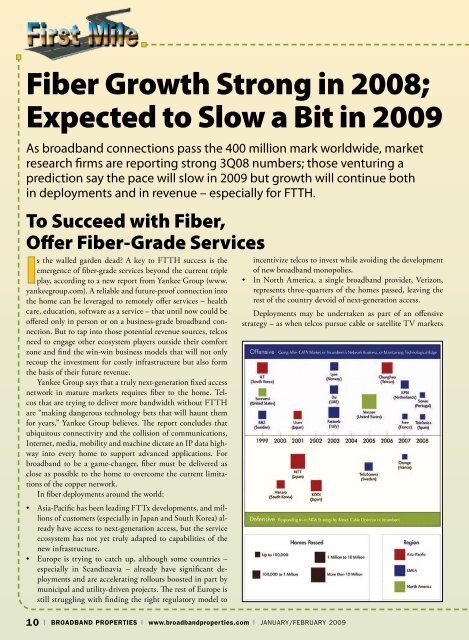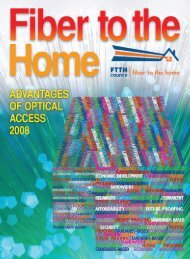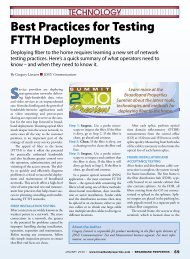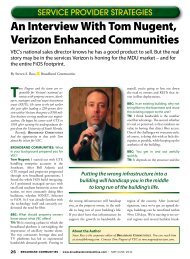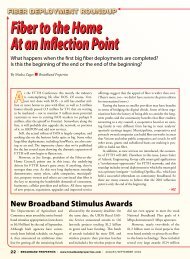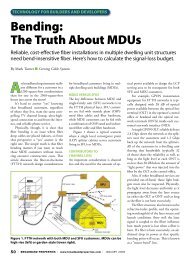bbpmag.com - Broadband Properties
bbpmag.com - Broadband Properties
bbpmag.com - Broadband Properties
Create successful ePaper yourself
Turn your PDF publications into a flip-book with our unique Google optimized e-Paper software.
Fiber Growth Strong in 2008;<br />
Expected to Slow a Bit in 2009<br />
As broadband connections pass the 400 million mark worldwide, market<br />
research firms are reporting strong 3Q08 numbers; those venturing a<br />
prediction say the pace will slow in 2009 but growth will continue both<br />
in deployments and in revenue – especially for FTTH.<br />
To Succeed with Fiber,<br />
Offer Fiber-Grade Services<br />
Is the walled garden dead A key to FTTH success is the<br />
emergence of fiber-grade services beyond the current triple<br />
play, according to a new report from Yankee Group (www.<br />
yankeegroup.<strong>com</strong>). A reliable and future-proof connection into<br />
the home can be leveraged to remotely offer services – health<br />
care, education, software as a service – that until now could be<br />
offered only in person or on a business-grade broadband connection.<br />
But to tap into those potential revenue sources, telcos<br />
need to engage other ecosystem players outside their <strong>com</strong>fort<br />
zone and find the win-win business models that will not only<br />
recoup the investment for costly infrastructure but also form<br />
the basis of their future revenue.<br />
Yankee Group says that a truly next-generation fixed access<br />
network in mature markets requires fiber to the home. Telcos<br />
that are trying to deliver more bandwidth without FTTH<br />
are “making dangerous technology bets that will haunt them<br />
for years,” Yankee Group believes. The report concludes that<br />
ubiquitous connectivity and the collision of <strong>com</strong>munications,<br />
Internet, media, mobility and machine dictate an IP data highway<br />
into every home to support advanced applications. For<br />
broadband to be a game-changer, fiber must be delivered as<br />
close as possible to the home to over<strong>com</strong>e the current limitations<br />
of the copper network.<br />
In fiber deployments around the world:<br />
• Asia-Pacific has been leading FTTx developments, and millions<br />
of customers (especially in Japan and South Korea) already<br />
have access to next-generation access, but the service<br />
ecosystem has not yet truly adapted to capabilities of the<br />
new infrastructure.<br />
• Europe is trying to catch up, although some countries –<br />
especially in Scandinavia – already have significant deployments<br />
and are accelerating rollouts boosted in part by<br />
municipal and utility-driven projects. The rest of Europe is<br />
still struggling with finding the right regulatory model to<br />
incentivize telcos to invest while avoiding the development<br />
of new broadband monopolies.<br />
• In North America, a single broadband provider, Verizon,<br />
represents three-quarters of the homes passed, leaving the<br />
rest of the country devoid of next-generation access.<br />
Deployments may be undertaken as part of an offensive<br />
strategy – as when telcos pursue cable or satellite TV markets<br />
10 | BROADBAND PROPERTIES | www.broadbandproperties.<strong>com</strong> | January/February 2009


